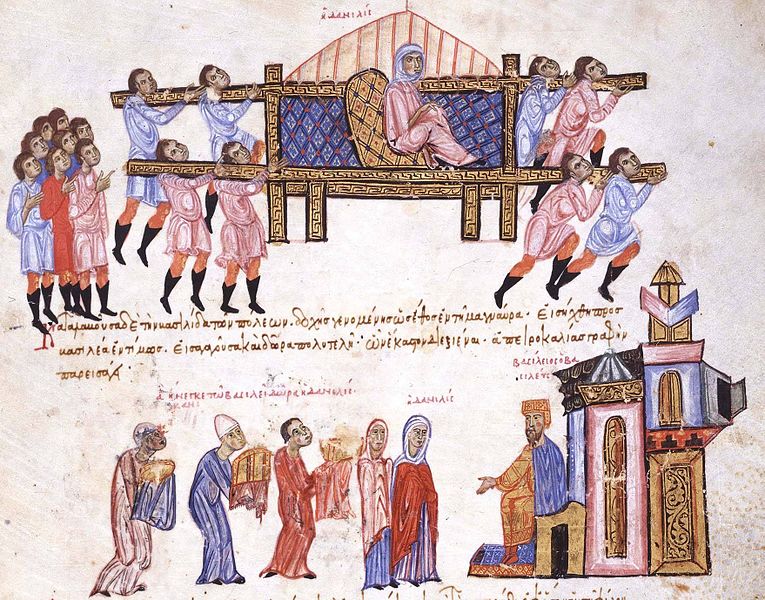A Byzantine Ancestor to Same-Sex Marriage?
SEXUALITIES, 4 Sep 2017
Mark Masterson – The Conversation
30 Aug 2017 – You might think same-sex marriage is something completely new. You would be mostly right, but history has other things to show us. History is not as familiar as we sometimes think it is.
Spiritual brotherhood in the Byzantine Empire of the Middle Ages is an ancestor to our same-sex marriage. In the Byzantine Empire men became spiritual brothers and some scholars believe that sexual intimacy did or could occur. There is some controversy about this. For some it is a bridge too far to speak of sex, for we cannot know for sure. My position is that it was a possibility at all times and the Byzantines were aware of this.
Brothers for life
First, how did men become spiritual brothers? In church two men would be blessed by a priest who would say a prayer over them. Many of these prayers survive and more are being located all the time. Spiritual brotherhood was popular.
Here is a portion of a prayer from the 800s:
… these your servants who love one another with spiritual love have come to your holy church to be blessed by you: grant them faith without shame, love without suspicion (Rapp, pg. 294)
After this blessing from the priest, the men were brothers for life. The Orthodox Church and Byzantine writers on law were nervous about the rite. There were questions about men’s motives for entering into these spiritual brotherhoods. Was it for sex with each other, easy access to each others’ households and women, or for criminal purposes (see Rapp, pg. 235)?
Experts have been divided about the question of sex between brothers joined in the rite. While there is not a lot of evidence and the rite was clearly not meant to allow men to have sex with each other, there is enough evidence to suggest that Byzantines thought affection and sexual feelings were possible.
It was well known that Emperor Basil I (mid-800s), who rose to the throne from modest circumstances, had a series of spiritual brotherhoods that were advantageous for him. The Byzantine historians writing in the mid-900s are not shy about noting that his good looks caught other men’s eyes:
Having gazed upon him, Theophilitzes [a member of the imperial court who was going to enrol Basil in his circle momentarily] desired Basil. (Pseudo-Symeon, Chronographia 656/11)
[Emperor Michael] was loving [Basil], gazing upon those [physical] qualities of his that surpassed all the others. (Anon., Life of Basil 13)
In the case of his first brotherhood, after Basil and the other man got back from the church, they “rejoiced in one another”. It is what it sounds like, especially as this rejoicing recalls Proverbs 5:18: “Rejoice in the wife of your youth”.
Beneficial liaisons
Prior to becoming emperor, Basil joined himself as brother to John who was the son of the fabulously rich widow, Danelis. This was Danelis’ idea. Basil benefited from Danelis’ resources and she later benefited from having her son associated with the emperor.
Later when Basil was emperor, Danelis visited the imperial court and was treated with great honour including being called “mother of the emperor”.
But that is not all. Just as we see in the histories, surviving letters that men wrote to each other show a culture of great warmth between men. The old language of male love that goes back to the ancient Greeks was used constantly. A handsome physique could inspire male desire.
Culture of male love
Another story will demonstrate this warmth. Here is the tale of four men around St. Mary the Younger. The Life of St. Mary the Younger, an anonymous text, was written probably in the 900s or 1000s.
St. Mary, who lived in the 800s, had a son, Vaanes. Vaanes, a soldier, was loved by the other soldiers. He was also particularly close to his friend Theodoros:
Vaanes had a certain Theodoros as … helper in all his excellent exploits … a man brave and strong in military matters but braver still in conducting his life for God. Yoked to him, like a bull of good lineage and strong, they were plowing in one another as though into rich farmland, and they were sowing the seeds of excellence, as though the best of farmers. (Life of St. Mary the Younger, pg. 279)
They are conducting their lives for god, but more is going on than that. “Yoked” is often used to refer to married couples and it is difficult to suppress thoughts of anal sex as they plow in one another. A spiritual life can be pretty bodily, it seems.
But it is not only Mary’s son. Her husband Nikephoros had a close relation with another man, named Vardas.
Vardas was married to Mary’s sister and he suggested to his friend Nikephoros that he marry Mary. A marriage connection would bring them closer together:
Since, O dearest of men to me, we have become deeply involved with each other and are bound by our intimate relationship. I think it right to make this, our bond of love, stronger and more perfect and to apply the ties of kinship to it, so that we may be joined in two ways, forging a family connection along with our intimate relationship. (Life of St. Mary the Younger, pg. 256)
When Vardas describes their relationship as intimate, again it is what it sounds like. If you ask, “intimate how?” you are asking the right question.
They could be and sometimes were
The take away is that two generations of men in the life of a saint had strong relationships with other men. The anonymous writer is not shy about making us think about sex either.
I also think it likely the writer of Mary’s life is signalling that these men were spiritual brothers as well as saying they were intimate with one another, just as Emperor Basil I was with his first brother.
A spiritual brotherhood was not same-sex marriage but it is an ancestor to it. It has a number of things in common with same-sex marriage. The relation is blessed by a priest (as a same-sex marriage can be). An intensity of emotion can be present, as well as desire and sex.
The great medieval empire was surprisingly unfussed.
____________________________________________
 Mark Masterson – Senior Lecturer of Classics, Victoria University of Wellington
Mark Masterson – Senior Lecturer of Classics, Victoria University of Wellington
Republish The Conversation articles for free, online or in print, under Creative Commons license.
Go to Original – theconversation.com
DISCLAIMER: The statements, views and opinions expressed in pieces republished here are solely those of the authors and do not necessarily represent those of TMS. In accordance with title 17 U.S.C. section 107, this material is distributed without profit to those who have expressed a prior interest in receiving the included information for research and educational purposes. TMS has no affiliation whatsoever with the originator of this article nor is TMS endorsed or sponsored by the originator. “GO TO ORIGINAL” links are provided as a convenience to our readers and allow for verification of authenticity. However, as originating pages are often updated by their originating host sites, the versions posted may not match the versions our readers view when clicking the “GO TO ORIGINAL” links. This site contains copyrighted material the use of which has not always been specifically authorized by the copyright owner. We are making such material available in our efforts to advance understanding of environmental, political, human rights, economic, democracy, scientific, and social justice issues, etc. We believe this constitutes a ‘fair use’ of any such copyrighted material as provided for in section 107 of the US Copyright Law. In accordance with Title 17 U.S.C. Section 107, the material on this site is distributed without profit to those who have expressed a prior interest in receiving the included information for research and educational purposes. For more information go to: http://www.law.cornell.edu/uscode/17/107.shtml. If you wish to use copyrighted material from this site for purposes of your own that go beyond ‘fair use’, you must obtain permission from the copyright owner.
